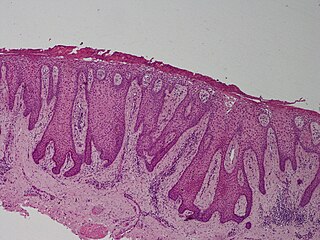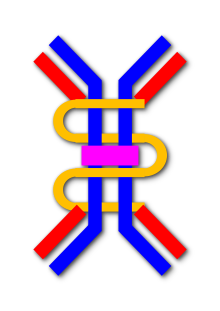
Pemphigus is a rare group of blistering autoimmune diseases that affect the skin and mucous membranes. The name is derived from the Greek root pemphix, meaning "blister".

Staphylococcal scalded skin syndrome (SSSS) is a dermatological condition caused by Staphylococcus aureus.

Sweet syndrome (SS), or acute febrile neutrophilic dermatosis, is a skin disease characterized by the sudden onset of fever, an elevated white blood cell count, and tender, red, well-demarcated papules and plaques that show dense infiltrates by neutrophil granulocytes on histologic examination.

Sneddon's syndrome is a form of arteriopathy characterized by several symptoms, including:

Dermatitis herpetiformis (DH) is a chronic autoimmune blistering skin condition, characterised by intensely itchy blisters filled with a watery fluid. DH is a cutaneous manifestation of coeliac disease, although the exact causal mechanism is not known. DH is neither related to nor caused by herpes virus; the name means that it is a skin inflammation having an appearance similar to herpes.
Pemphigus foliaceus is an autoimmune blistering disease of the skin. Pemphigus foliaceus causes a characteristic inflammatory attack at the subcorneal layer of epidermis, which results in skin lesions that are scaly or crusted erosions with an erythematous (red) base. Mucosal involvement is absent even with widespread disease.
Impetigo herpetiformis is a form of severe pustular psoriasis occurring in pregnancy which may occur during any trimester.
Erosive pustular dermatitis of the scalp presents with pustules, erosions, and crusts on the scalp of primarily older Caucasian females, and on biopsy, has a lymphoplasmacytic infiltrate with or without foreign body giant cells and pilosebaceous atrophy.

Pustulosis palmaris et plantaris is a chronic recurrent pustular dermatosis localized on the palms and soles only, characterized histologically by intraepidermal pustules filled with neutrophils. It can occur as part of the SAPHO syndrome.

Transient neonatal pustular melanosis (TNPM), also known as pustular melanosis, is a type of neonatal pustular eruption that is a transient rash common in newborns. It is vesiculopustular rash made up of 1–3 mm fluid-filled lesions that rupture, leaving behind a collarette of scale and a brown macule. The lesions are fragile and with no surrounding erythema. This rash occurs only in the newborn stage, usually appearing a few days after birth, but pigmented macules are sometimes already present at birth. The rash usually fades over three to four weeks but may linger for up to three months after birth. It can occur anywhere on the body, including the palms and soles.

Linear IgA bullous dermatosis is a rare immune-mediated blistering skin disease frequently associated with medication exposure, especially vancomycin, with men and women being equally affected. It was first described by Tadeusz Chorzelski in 1979 and may be divided into two types:
Reactive neutrophilic dermatoses are a spectrum of conditions mediated by neutrophils, and typically associated with underlying diseases, such as inflammatory bowel disease and hematologic malignancy.
Neutrophilic dermatosis of the dorsal hands (NDDH) is a skin condition that presents with edematous pustular or ulcerative nodules or plaques localized to the dorsal hands.

Clear cell acanthoma is a benign clinical and histological lesion initially described as neoplastic, which some authors now regard as a reactive dermatosis. It usually presents as a moist solitary firm, brown-red, well-circumscribed, 5 mm to 2 cm nodule or plaque on the lower extremities of middle-aged to elderly individuals. The lesion has a crusted, scaly peripheral collarette and vascular puncta on the surface. It is characterized by slow growth, and may persist for years. The clinical differential diagnosis includes: dermatofibroma, inflamed seborrheic keratosis, pyogenic granuloma, basal-cell carcinoma, squamous cell carcinoma, verruca vulgaris, psoriatic plaque, and melanoma.

Immunodeficiency with hyperimmunoglobulin M is a rare disorder characterized by recurrent infections, low or absent IgG, IgE, and IgA levels, and normal or elevated levels of IgM and IgD.
Rheumatoid neutrophilic dermatitis, also known as rheumatoid neutrophilic dermatosis, is a cutaneous condition associated with rheumatoid arthritis.

Bowel-associated dermatosis–arthritis syndrome (BADAS), is a complication of jejunoileal bypass surgery consisting of flu-like symptoms, multiple painful joints (polyarthralgia), muscle aches (myalgia) and skin changes. It has been reported to occur in up to 20% of patients who had jejunoileal bypass surgery, a form of obesity surgery that is rarely performed today.
Neutrophil immunodeficiency syndrome is a condition caused by mutations in the Rac2 gene.

Peter Edward Darrell Sheldon Wilkinson was a leading figure in dermatology who was consultant at Aylesbury and High Wycombe, co-edited the first edition of Rook's 1968 Textbook of Dermatology and founded the International Foundation for Dermatology in 1987.












